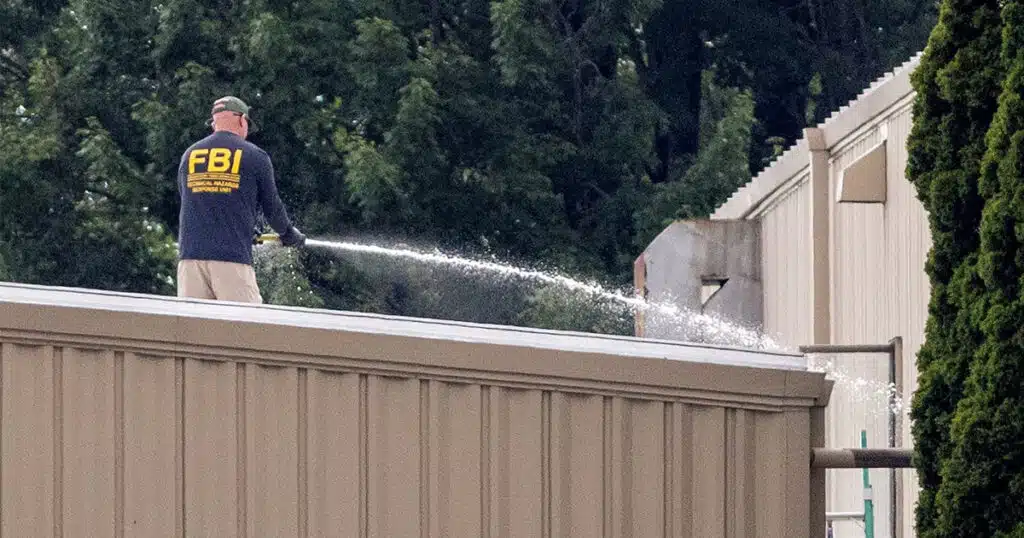
Secret Service “Sloped Roof” Saga Takes New Turn
One year after the assassination attempt against President Trump, new details have emerged about a dispute between the Secret Service and Trump campaign staffers regarding the use of farm equipment to block a vulnerability at the rally that shooter Thomas Crooks exploited to nearly kill Trump, murder Corey Comperatore, and injure two other rallygoers.
Former Secret Service Director Kimberly Cheatle’s farcical testimony to Congress that the USSS counter snipers or local police couldn’t place themselves on top of the building where Crooks fired his shots because the sloped roof posed a safety hazard could go down in history as one of the worst explanations for a systematic failure in modern history.
The obviously ludicrous argument inspired countless viral memes: cows standing on sloped roofs, Secret Service agents walking on the sloped roofs of the White House, USSS counter snipers at the Butler rally kneeling on a different sloped roof nearby, even patches depicting Santa holding a rifle above the words “sloped-roof qualified.”
All kidding aside, the Secret Service’s failure to adequately cover that roof remains largely unexplained, a sore point between local law enforcement officers in Butler and the Secret Service – one that trained shooters have argued is a vulnerability too egregiously obvious to miss.
But new details are emerging that some of the Secret Service’s reasons for leaving that rooftop open not only had nothing to do with the pitch of the rooftop, but may have been, at least partially, because an inexperienced agent, and possibly her superior, were trying too hard to please Trump’s campaign staff.
A few weeks after Trump nearly escaped death at the Butler rally, RealClearPolitics learned of an initial disagreement between the Secret Service and Trump campaign advance staff over the agency’s desire to use farm equipment to block the line-of-sight vulnerability between the American Glass Research or AGR building and the stage where Trump would eventually get shot in the head.
At the time, sources declined to discuss the matter with RCP on the record, so it proved impossible to obtain clear, reliable information. However, on Saturday, Sen. Chuck Grassley released a report he commissioned from the Government Accountability Office that detailed the dispute over the farm equipment.
That report asserts that a Trump campaign staffer, objecting to the optics, “asked members of the Secret Service advance team not to use large farm equipment to address line-of-sight concerns near one of the buildings — the AGR building — located near the rally presentation stage.”
The GAO report said the staffer voiced “significant concerns” that the equipment “would interfere with campaign press photos.” The staffer then “pressed the Secret Service advance team to develop another solution to address the line-of-sight concerns,” so the Secret Service advance team “deviated” from its original plan to use the farm equipment, and chose other alternatives, such as a “jumbotron and a large flag,” to attempt to address the vulnerability. That attempt, however, was unsuccessful when Crooks easily climbed up onto the AGR building and opened fire on Trump and the crowd with a virtually unobstructed line of sight.
It now appears that the Secret Service agent involved with devising the security plan for Butler and her supervisor may have caved too easily and certainly didn’t put up much of a fight or escalate the matter back to headquarters, which could have made a stronger case to campaign staff as to why it was necessary. According to the GAO report, the Secret Service team, which participated in the “back-and-forth discussion” with the campaign staffer about the farm equipment, did not share the staffer’s input with senior-level Secret Service officials overseeing the rally.
As a result of that protocol failure, Tim Burke, special agent in charge of the Pittsburgh Field Office, and Sean Curran, who now serves the USSS director and served as the chief of the Donald Trump campaign detail at the time, and other Secret Service leaders were “unaware [that] the advance team chose not use the farm equipment to address the line-of-sight vulnerability based on input from a staffer.”
“If the Secret Service advance team would have informed someone in a leadership position, Secret Service leadership could have played a role in ensuring a suitable alternative line-of-sight mitigation solution was implemented,” the Grassley report states.
The key agents charged with devising and executing the security plan are the site agent, Myosoty Perez, a junior agent from the Donald Trump campaign detail, and the lead agent, Meredith Bank, a mid-level agent out of the Pittsburgh Field Office.
Perez and Bank are two of the six agents whom the Secret Service has suspended without pay for their roles in the Butler failures. In both of their suspension documents, successfully subpoenaed by the Senate Homeland Security Committee in early July, each was faulted for failing to cover the AGR building properly or to mitigate the line-of-sight issues created by the building. Perez, who had just 3.5 years in the Secret Service at the time of the Butler rally and no experience leading security for a big outdoor event attracting thousands of people, received the highest suspension the agency doled out – 42 days without pay, though even that is a mild suspension. Bank, a mid-career agent, had far more experience, including experience in Washington on a vice-presidential detail.
Some sources in the Secret Service community are taking issue with any notion that junior agents in charge of advance could make such a decision to alter a security plan without getting sign-off from a USSS supervisor.
“I don’t understand how senior Secret Service agents could say that they had no idea that we deviated from the plan, because that should have come up during the walk through and count-down meetings and the plans diagrams would have reflected farm equipment,” one source told RCP. “To change it, supervisors would have to have asked. I call bull shit on that.”
It’s nearly impossible to determine if having the farm equipment in place would have completely blocked or prevented the gunman from using the AGR building to carry out his assassination attempt, the Grassley report states, with a caveat.
“However, not using the farm equipment possibly created an opportunity for the gunman to use the AGR’s elevated rooftop to fire several shots at then-former President Trump and kill and injure other rally participants,” the GAO report states.
If it were a foolproof plan, the Secret Service advance agents likely could have pressed their case a lot stronger and even overruled the campaign staffer to ensure Trump’s security. But it’s clear from the Senate report that agents making these decisions were easily persuaded against using the farm equipment as barriers by Trump campaign staffers.
The White House on Monday clarified that the campaign staffer merely raising questions about the farm equipment idea in no way amounted to a denial or rejection of the Secret Service’s plans to use it.
White House press secretary Karoline Leavitt told RealClearPolitics Monday that the Trump campaign staffer never denied the Secret Service’s request to use farm equipment to block the line-of-sight vulnerability that Crooks exploited. Instead, Leavitt said, there was a discussion between the staff and the Secret Service on what type of security measures would be best.
“As the Trump campaign stated at the time, the [Secret Service] request [to use farm equipment] was not denied,” Leavitt, who served as a campaign spokeswoman before taking the White House press secretary role, told RCP in a statement. “The request was discussed between campaign advance staff and the USSS to ensure optimal site set up for the president and his guests, with the understanding that Secret Service is ultimately responsible for line-of-sight concerns.”
The Secret Service did not immediately respond to RCP’s request for comment and clarification.
Multiple Secret Service sources tell RCP it’s normal for the campaign staff to take issue with the optics of security measures the Secret Service recommends, because they can be unsightly or obscuring for the crowd or for the press. In those cases, negotiations occur, and if junior agents think security should overrule optics, they can escalate the matter within their chain of command so supervisors can step in to take over the negotiations – and if necessary, press their case to the senior campaign staff that certain security measures are necessary.
The Secret Service ultimately has the power to make the final call if any disputes remain about security solutions for a site, but Trump and his team obviously cared deeply about the optics of their sites, especially during the 2024 campaign, so it might have been hard for an agent to navigate those negotiations.
During testimony before congressional investigators last year, Burke asserted that he conducted a walk-through of the Butler site on the Wednesday before the July 13 rally and was informed by Perez that the farm equipment would be used to mitigate the AGR building line-of-sight vulnerabilities.
However, in any type of dispute between a campaign staffer and a USSS agent over optics versus security measures, the campaign can “overrule” a Secret Service recommendation, even though it does not appear that Perez pushed back enough at the campaign staffer’s objection for the discussion to escalate or even to register as a significant dispute.
When asked by a congressional investigator who gets the final say, the USSS or the campaign staff, when there’s a dispute between optics over security, Burke testified that it’s the Trump Secret Service detail who can ultimately win out if negotiations intensify to the point in which the Secret Service needs to step in and assert that the advance work needs to err on the side of security.
“It’s my understanding that the Trump [Secret Service] detail sends out a site agent because of their working relationship with [campaign] staff,” Burke testified. “So, this would go through the detail. So, if it was brought to my attention ahead of time, and I said, ‘Hey, I believe we need to – this needs to happen,’ I could get overruled by the Trump detail.”
Burke testified that he was never made aware of the concerns expressed by Trump’s campaign staff about the farm equipment or trucks, or other machinery, and believed up until the rally and the fallout over the assassination attempt that the equipment was being used to help mitigate vulnerabilities.
“During the walk-through [on Wednesday], we talked about line-of-sight issues, what are we doing to mitigate line of sight, because the entire field was a line-of-sight,” he said. “It was just line-of-sight issues everywhere.”
“I was told throughout the walk-throughs that the Butler Farm Show had, [that] there was somebody connected with the Butler Farm show itself or a vendor they used [who] had offered large farm equipment – combines, and other things, to use to block line-of-sight wherever we needed it, and it was free of charge is what I was told,” Burke said.
Burke also noted that he was told the AGR building would be closed and locked, and there would be “roving police posts” around to provide more protection from someone getting into the building and causing a security threat.
In his unsuccessful attempts to fight his suspension or get the 14 days reduced, Burke argued that he was kept in the dark about the change in the security plans not to use the equipment, along with not being briefed about the new Iranian threat to Trump that Secret Service top brass and Trump campaign leaders had already been read in on.
Grassley’s report found that Secret Service leaders knew 10 days before the Butler rally about new intelligence of an Iranian threat to Trump but briefed only the supervisors of the Trump detail and the lead agent from the Pittsburgh Field Office, but not Perez and other agents from Pittsburgh, and no local law enforcement officers assisting in the rally security planning and execution.
Eventually, a red truck was used to block the line of sight from the AGR building on the ground, a knowledgeable source tells RCP. The roof line-of-sight, however, remained addressed only by having local law enforcement officers assigned to the AGR building. Perez and her supervisors allowed local law enforcement officers, two snipers from the Butler County Emergency Services Unit, to position themselves inside the building instead of on the roof, leaving the roof open for Crooks to crawl onto it and fire off his shots before a Secret Service counter sniper shot and killed him.
One of the communication problems about the farm equipment might have occurred because at the time of the rally, the Secret Service had no processes in place requiring the advance team to document changes to the site plan based on recommendations received from non-Secret Service personnel, according to the GAO report.
In April, Curran instituted a new policy to deal with non-Secret Service requests to change the site plans and would require supervisory notification and sign-off for those alterations. The policy requires that “during the entirety of the advance process and ensuing visit,” Secret Service personnel are required to work with their campaign or other staffers for Trump and other protectees to identify any conflicts between protectee staff requests and protective needs to ensure protective needs are met.”
“Secret Service personnel will work diligently with protectee staff counterparts to resolve conflicts regarding protective needs,” the policy states, requiring the matter to be elevated to their chain-of-command at the supervisor level, and “at last resort, to the executive level.”
The policy also requires agents to document everything in emails.
This article was originally published by RealClearPolitics and made available via RealClearWire.



